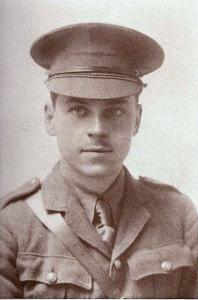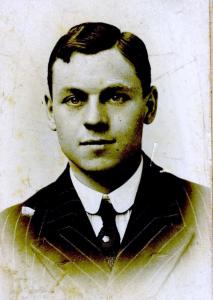
|

|
| 2nd Lieutenant Hugh Bertram NEELY | |
|
3rd (Reserve) Battalion Suffolk Regiment attached to 13 Platoon, A Company, 1st Battalion Date of birth: 27th June 1888 Date of death: 25th May 1915 Died of wounds aged 26 Buried at Vlamertinghe Military Cemetery Plot I Row E Grave 7 |

|
| Hugh Bertram Neely was born at “Dellcot”, Elmfield Road, Bromley in Kent on the 27th of June 1888 the second son of William Neely, a stationer, and Clare Rebecca (nee Cope) Neely of Ruxley House, 157 Widmore Road, Bromley. He was educated at Quernmore School at Bromley and at Lancing College where he won an Exhibition and was in News House from September 1902 to March 1905. He was a Sergeant in the Officer Training Corps and was a Prefect in 1904. He passed the London Matriculation in January 1905. On the 14th of August 1905 he left for Luneray in Northern Normandy and, on the 2nd of October, he moved to Rouen. On his return from France he was articled to R.M. Roe, architects but he cancelled his articles in 1908. On the 21st of October 1908 he entered Guy’s Hospital to train as a dentist and passed his final exams in November 1912, becoming MRCS and LRCP. He was Assistant Demonstrator of Dental Metallurgy from January to March 1911 and was Assistant Dental House Surgeon at Guy’s from July to September 1912. On leaving Guy’s he was registered as a Dentist on the 2nd of January 1913 and entered into private practice where he worked as an assistant in two or three posts before establishing his own practice in Southampton at 3 London Road on the 19th of May 1913. He was received into the Catholic Church on the 23rd of February 1913. He was a member of the committee of the Lancing Club for a short time and, although he didn't obtain school colours for football while at Lancing, on leaving he played for Guys Hospital, United Hospitals (1911/12), where he was Hon Secretary, as well as for the OLs, for Kent and for Surrey. He also played rugby for the Southampton Trojans. He served as Private 1587 in the 28th (County of London) Battalion (Artists Rifles) from October 1908 to 1913 when he moved to Southampton. On the outbreak of war he closed his practice and rejoined his old regiment, the Artists Rifles, at Dukes Road, Euston Road on the 6th of August 1914. At a medical examination, which was held on the same day, it was recorded that he was five feet ten and a half inches tall. He was commissioned as a 2nd Lieutenant on probation in the 3rd Battalion Suffolk Regiment on the 15th of August 1914 although his application for a commission was dated the 24th of September 1914. Shortly afterwards he was sent for a musketry course at Hythe and qualified in the use of the machine gun. He left for France from Waterloo Station at 6.55pm on the 4th of March 1915 landing there the following morning where he was attached to the 1st Battalion of his regiment. He joined them in the field at Dranoutre on the 26th of March. On the 22nd of April 1915 the Germans launched a major offensive at Ypres. They opened their attack by releasing chlorine gas, the first time gas had been used as a weapon of war. They had widespread success in breaking through the allied lines and began advancing across the now largely open country opposed by scattered allied units. On the night of the 23rd/24th the 1st Battalion Suffolk Regiment came out of the line and into Brigade reserve between Frezenberg and Verlorenhoek reaching their new position at dawn on the 24th. Their Commanding Officer, Captain Balders, issued orders for the construction of a defensive line but shortly after this a staff officer arrived to inform him that the Germans had broken through and that he should move forward to the village of Fortain to meet them and engage any enemy elements he came across on the way. By this time the Germans were already shelling his battalion and as they moved forward the shelling became heavier and was coming from three sides, an indication of how perilous their position was becoming. On their way they came across a Canadian formation and were asked to give their support to them. By this time Balders had also taken Command of the 12th (County of London) Battalion (The Rangers) as their commanding officer had become a casualty and shortly afterwards a wounded Canadian officer informed him that the Germans had already broken through on the Canadian left. While talking to two Canadian staff officers, who were trying to impress on him the need for his help, they both became casualties and he agreed to assist. By this time the battalion was coming under rifle and machine gun fire and it became clear that the village of St Julien, which Balders had believed to be in British hands, had fallen. He therefore ordered two companies forward to assist the Canadians, instructing the rest of his men to construct a new trench which they spent the night digging. For the next three days they were under almost constant rifle and machine gun fire, as well as shelling, but held the line until they were relieved on the night of the 26th/27th of April. Casualties during the period of the fighting were around four hundred of whom Hugh Neely was one. He was evacuated but died of his wounds later that day at 2nd Canadian Field Ambulance. His father received the following telegram dated the 27th of April 1915: - "Deeply regret to inform you that Second Lieutenant H.B. Neely Suffolk Regiment was killed on 25 April. Lord Kitchener expresses his sympathy." Eye witness statements were taken from members of his unit in order to establish the events leading to his death. Statement of Private 8171 Barrett, 13 Platoon, D Company 1st Battalion Suffolk Regiment taken at No. 5 General Hospital, Rouen on the 22nd of May 1915: - "Witness was in Lt. Neely's platoon, No. 13. The regiment made a successful attack on the Germans after having been for 6 days in the trenches. This officer was hit during the attack. Witness saw him standing up with L/Cpl. Ayres, who, so far as witness knows, is alright and a stretcher bearer. They took him to the dressing station. Witness knows that he died but knows no more. He said of his own accord that "Everybody in the regiment gave Lt. Neely a good name." Statement of Private W. Foreman 1st Battalion Suffolk Regiment given at V.A.D. Hospital, St Aidan's Institute, New Cleethorpes, Grimsby, Lincolnshire on the 22nd of June 1915: - "I wish to inform you that he was my Platoon Officer, and I was near him when he fell on Saturday April 25th. I can give details as to Mr. Neely's wounds but do not know where he was buried. If the above details are of any use would kindly inform me." Guy's Hospital Report recorded the following about him:- "In the heavy fighting which took place around Ypres about the end of April, he was one of the many officers who fell in action - brave men who gave their lives cheerfully and willingly for their country. We men of Guy's can realise what a loss he must have been to his men, for he was always a man who though for others before himself." His brother, 2nd Lieutenant Clive William Neely OL 6th Battalion Loyal North Lancashire Regiment, died on the 26th of June 1916. He is commemorated on the war memorial at Guy's Hospital and on the memorial at St John the Evangelist Church, Bromley. |
|
 | |
| News House |
Back